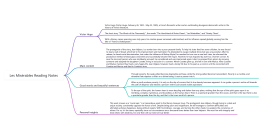Reading Notes on Notre Dame de Paris
2024-08-29 13:51:58 163 0 Report 0
0
Login to view full content
This mind map serves as a reading note of 'Notre Dame de Paris,' a novel by Victor Hugo, a prominent French Romantic writer. Set against the backdrop of 15th-century Paris, the novel explores themes of love, betrayal, and societal injustice through the tragic fate of the gypsy girl Esmeralda. The narrative criticizes religious hypocrisy and celebrates the virtues of the working class. Hugo's characters, such as the deformed yet kind-hearted Quasimodo, embody the struggles of the oppressed. 'Notre Dame de Paris' has had a lasting impact on literature, breaking classical constraints and becoming a cornerstone of Romantic literature.
Other creations by the author
Outline/Content
Author's profile
Victor Hugo, a French Romantic writer and a representative figure of humanitarianism, was a bourgeois democratic writer in the history of French literature. He experienced almost all the significant events of 19th-century France and was known as the "Shakespeare of France."
Work theme
The novel depicts the fate of a gypsy girl named Esmeralda, who was framed by the bishop, rescued by Quasimodo, but ultimately could not escape the noose. It reveals the hypocrisy of religion, declares the bankruptcy of asceticism, and celebrates the kindness, friendship, and selflessness of the working class, reflecting Hugo's humanitarian ideology.
creative background
In France, the Bourbon Dynasty, which had been overthrown by the bourgeois revolutionary regime, was restored in 1815 with the support of foreign feudal forces. It was not until 1830, when the "July Revolution" broke out in France, that the feudal rule of the Bourbon Restoration was brought to an end.
Under the reign of the restored monarchy, the French court and the church colluded to oppress the people. At that time, Paris was under the evil and dark influence of religious forces, and the feudal hierarchy was extremely brutal, with feudalism suppressing humanity and leading to its distortion and degradation. All levels of society, especially the lower classes, were in a situation that evoked deep sympathy. The oppressed masses rose up in rebellion, engaging in a valiant struggle against these two forces, and ultimately achieved victory. Hugo felt the darkness and cruelty of feudal rule and created "The Hunchback of Notre-Dame," using 15th-century Parisian society to reflect contemporary life.
The title "The Hunchback of Notre-Dame" refers precisely to the location where the story takes place—the Notre-Dame Cathedral. In 1829, Victor Hugo began writing "The Hunchback of Notre-Dame" with the intention of making people of his time appreciate the value of this Gothic architectural masterpiece.
main content
The ugly deaf man Quasimodo was adopted by the priest Claude of Notre-Dame de Paris to be the bell-ringer. The respectable-looking Father Claude, after meeting the beautiful Gypsy girl Esmeralda, was seduced by her beauty and became utterly infatuated. He ordered Quasimodo to abduct Esmeralda by force, but they were rescued by Captain Phoebus of the cavalry. As a result, Esmeralda fell in love with Phoebus.
But Foubis, by nature a womanizer, was stabbed by the resentful Claude, though he did not die.
And framing Esmeralda, he caused her to be sentenced to death. During the execution, Quasimodo rescued Esmeralda and hid her in Notre-Dame Cathedral. The beggars stormed the church to save Esmeralda, mistakenly engaging in a fierce battle with Quasimodo. Esmeralda was hanged by an army led by Claude Frollo in the square. In anger, Quasimodo threw Claude from the cathedral rooftop to the ground. Finally, Quasimodo, mourning over Esmeralda's body, died of love.
Character introduction
Quasimodo
Quasimodo was the typical representative of the impoverished masses of society at the time.
Quasimodo was abandoned by his parents at the doorstep of Notre-Dame de Paris as a child. He is a deformed child with a "geometric face, tetrahedral nose, horseshoe-shaped mouth, uneven teeth, one eye, deafness, a hunchback, and a voice that is ugly yet honest." The author uses exaggerated physical features to highlight his character traits.
Esmeralda
Esmeralda is the perfect artistic image embodying truth, goodness, and beauty in Hugo's writings.
The author has imbued Esmeralda with ideals and hopes, but religious nobility and dark forces would never allow the existence of Beautiful things.
Claude Frollo
Claude demonstrated the essence of human nature. Claude received good religious education since childhood, he was a diligent, studious, positive, and well-educated young man. He adopted the ugly Quasimodo and took care of his young brother, which shows that he has a bit of kindness.
Hugo used Claude's image to represent a part of the aristocracy, ostensibly upholding justice and protecting the weak, but in reality, they were sanctimonious and self-serving, revealing the darkness and sins of the aristocratic class.
Phoebus de Châteaupers
Phoebus is the embodiment of a heartless, ungrateful, cold, and ugly person. He is a captain of the royal guard who is handsome and charming, popular and beloved by girls, but inwardly he is a hypocrite with a honeyed tongue and a sword in his heart, indulging in dissolute behavior.
The writer Hugo precisely portrayed the appearance of Phoebus, which further highlighted the ugliness and filthiness of the character's soul, creating a stark and vivid contrast between the exterior and the inner self.
The impact of the work
The literary value and social significance of "The Hunchback of Notre-Dame" have had a profound impact. This novel broke the shackles of classicalism and stands as a milestone in romantic literature. Since its release, "The Hunchback of Notre-Dame" has been adapted into movies, animated films, plays, and more, multiple times.
work controversy
This book was banned during the reign of Tsar Nicholas I in Russia, as Hugo's thoughts were active, showing tendencies of bourgeois liberalism, and he also sympathized with the emerging proletarian revolution. Therefore, the conservative and stubborn tsar ordered the prohibition of publishing all of Hugo's works in Russia.

Collect

Collect

Collect
0 Comments
Next page
Recommended for you
More












